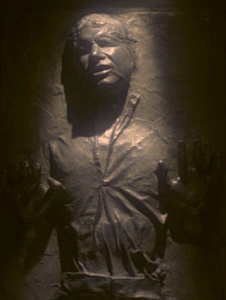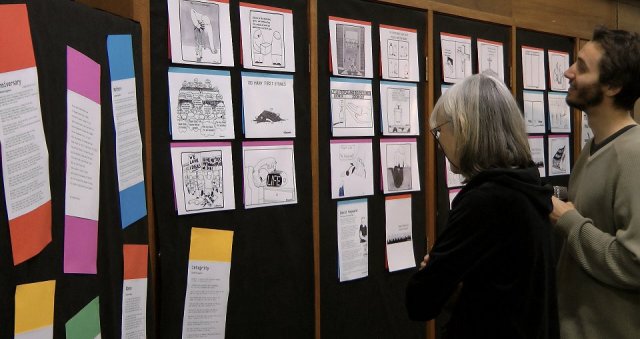 The Art of Creating and Maintaining Suspense in Writing
The Art of Creating and Maintaining Suspense in Writing
The generous application of palpable suspense in a novel, a screenplay, or any other form of writing, is an incredibly powerful tool in the hands of the skilled author.
The word suspense has its roots in the Latin suspendere, meaning to hang up or put on the shelf, the Medieval Latin suspensum, meaning to delay, and in the Late Middle English word, deriving from the Anglo-French, suspendre, meaning to suspend. The word is pregnant with shades of meaning, evoking such strong concepts as anxiety, uncertainty, expectation, excitement, and beyond. Utilizing these concepts with great skill, the author makes us wait, progressively orchestrates a feeling of anxiety within us, and, then, takes us right to the edge where nerves are literally frayed from the unrelenting pressure of the tension evoked.
Suspense can just as easily ride along waves of hatred, fear, love, or hope. It works equally well whether we already know the outcome of a particular work or film, such as the Last of the Mohicans, or, if we don’t know how everything will turn out, such as the enigmatic novel, Ulysses.
Extraordinary situations have the power to elicit an enormous amount of suspense, yet, life ordinary situations also have the ability to pluck at our heartstrings and emotions in ways that resonate with the very depths of our soul.
One such amazingly tension-ridden image has been etched deeply into my consciousness. In it, Han Solo, played by Harrison Ford in The Empire Strikes Back, finds himself encased in an ugly, bronze colored, shiny chamber of Carbonite, his life now in a tenuous state of suspended animation. Having seen the transformation from living, breathing human being to wall mounted trophy happen before my eyes, there was a literal craving within me to know what would happen to him! I absolutely had to see the sequel! The power of not knowing, exemplified!
Few of us would be old enough to remember the Saturday afternoon matinee in which beautiful damsels would often be tied to railroad tracks with a steam locomotive headed full speed towards them, but those of us who do will also vividly recall the unbearable tension created by the horrible image.
Here, the suspense draws its power from the creation of an impossible situation from which the hero or heroine cannot possibly escape unaided. The classic line by Auric Goldfinger epitomizes such tension-filled scenes: “No, Mr. Bond, I expect you to die!” And, that is the reason we keep turning the pages, one after the other, because we simply have to know how it all ends! Will James Bond become a soprano, or worse?
As a prerequisite to powerful tension, the effective author must create a deep sympathy for the character or characters he or she has created. Once upon a time, the men wearing the white hats would win and those with black hats would lose, so our natural connection would be with the hero or heroine.
However, there has been a surprising trend in many books and films where the author has us experience an outstanding connection with someone we would ordinarily consider to be a bad guy, thief or thug. Because the writer has so powerfully endeared these characters to our hearts, we actually want them to win, to escape, or to get away with whatever they’re trying to get away with! Who among us didn’t want the Sean Connery and Catherine Zeta Jones characters in Entrapment to outsmart the authorities? Who was actually wishing Bonnie and Clyde would be killed in the end? And, admit it to yourself, weren’t you secretly hoping that our on screen friend, Robert Redford, in Butch Cassidy and the Sundance Kid, would make it out alive?
Suspense, however, is not limited to action adventure scenarios. Romance and unrequited love possess great power to evoke unmitigating, compelling emotional tension. Will he win over the girl? Will she endear her man?
These have been heart-rending themes for countless works of poetry, plays, novels, and film scripts for centuries, and, rightly so, as they are the undeniable essence of so much of what makes us human. In the perennially popular Back to the Future film series, we witness the power of love motivating the characters to go to the most extraordinary lengths to secure a future together. The Doc, superbly played by Christopher Lloyd, is smitten in the late 1800’s with a beautiful woman, Clara, and does everything in his power to secure her love. Clara, delightfully portrayed by Mary Steenburgen, is equally smitten and abandons all logical thinking and risks potential death in order to be with the one she loves. And all along the way we feel the tension. Even though it is a romantic comedy, we watch with bated breath, hoping for a positive outcome.
Or, how about young Dustin Hoffman naïvely making his way through life in the Graduate, until he finds himself lured into Mrs. Robinson’s bedroom? Will he or won’t he, we ask ourselves, perhaps reliving some childhood angst emanating from deep within us. The tension created is palpable and ever so effective!
What about that typical Hollywood invention, the chase scene? My favorite would have to be Steve McQueen driving that excellent, customized 1968 Max Balchowsky Mustang 390GT 2+2 Fastback in the film, Bullitt. The streets of San Francisco have never been bouncier! I must have seen hundreds of chase scenes in my life or read them in books, and yet I must confess, I never tire of them and they never disappoint me. A well crafted chase scene has the singular ability to create an excellent sense of excitement coupled with a tangible feeling of danger within me!
Speaking of excitement and danger, how about Alfred Hitchcock, the master of suspense, with movies like Rear Window and Psycho. Albeit now dated, their power to keep us on the edge of our literal seats continues unabated. After all, Norman Bates is a household word. The Master truly knew how to build suspense upon tension upon anxiety in an unrelenting, unmerciful manner that was simply exquisite.
I generally do not watch horror as a genre, but what happens when horror meets science fiction? When the former Governator played the Terminator, chased by an even more advanced, liquid metal Terminator from the future, I’m sure your stomach was in as much of a knot as mine. The taking down of Cyberdyne Systems was an amazing cliffhanger, culminating in the lead scientist there finally releasing the deadman’s switch as he, himself, died. Or how about the Alien series with those pesky, all pervasive, massive bug-like creatures that could come out of anywhere at any time and did? Is it really true that in space no one can hear you scream? The level of tension in the first film of the franchise is nothing less than stellar, pardon the pun! Suspense here in the not knowing as much as it is in seeing it coming at us!
And, then, of course, there is that incredibly effective, once nearly ubiquitous, tension building devise that revolves around the simple words, “To Be Continued!” Kate Mulgrew’s plight as Captain Kathryn Janeway in Star Trek Voyager is interrupted by those very words when she is forced to participate in a bizarre sequence of war games in an alien version of Nazi times. Again, the driving force created by the tension of not knowing how things would turn out created an incredible hunger for the next episode! The number of novels that have cascaded into two, three, or more sequels is amazing, but, more rare is the novel that ends in a cliffhanger, relying on the next one in the series to bring our rapidly beating, anxious hearts some form of relief.
In writing we achieve incredible tension when one of the characters we have so lovingly created is left in the hands of an evil nemesis, hanging, as it were, by a thread. The ever popular Mel Gibson in Lethal Weapon 4 is left literally hanging from a rope around his hands, bare chested, soaking wet and about to be the proud owner of some very serious electrical scars on his body courtesy of a very evil-looking bad guy. Our anxiety running high, we are left with our heart in our throat as the director decides to take us to another plot thread to see what is happening there! Fortunately, when we return, we find Martin Riggs does an amazing job of kicking the daylights out of his assailant, just in time for another dose of sweet suspense!
Perhaps the most enduring memory I have is from the film, Cliffhanger, in which the inimitable Sylvester Stallone, playing mountain man Gabe Walker, is forced to dive into a fierce, icy stream running under thick, semi-transparent ice by some incredibly bad guys. To see his face looking through the frosty crust, freezing to death, certainly had me screaming inside, How in the world will he ever get out of this?!!! He does, making it through an incredible maze of further suspenseful scenarios, but, what a ride! A true cliff hanger!
In terms of tension, it seems, the more drawn out you can make it, the better! Increasing the suspense amplitude by continually dialing up the number of possible sources of tension also seems to be the go. Apparently, it’s not so important what happens in between suspenseful scenes as it is to ensure that the audience or the reader is left hanging, begging for more!
Your assignment is to write the end of a chapter, a poem or a script that makes your readers do just that, beg for more!
Of course, the perennial favorite is a notecard with the words — How do you keep a turkey in suspense? — Written on both sides of the card.
![]()
![]()
![]()
![]()









 “If there’s a book you really want to read but it hasn’t been written yet, then you must write it.” – Toni Morrison
“If there’s a book you really want to read but it hasn’t been written yet, then you must write it.” – Toni Morrison